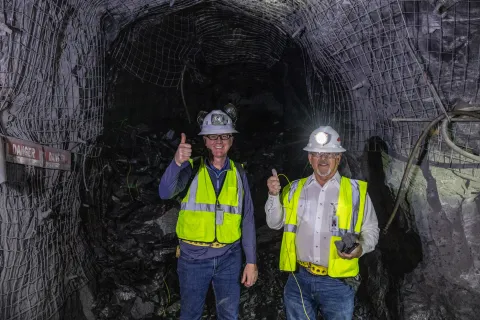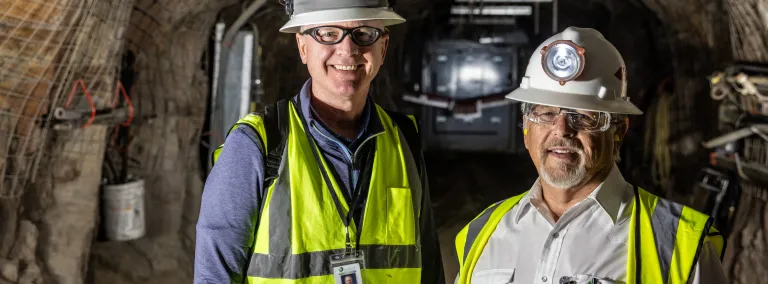SURF begins excavation to expand underground research space
The Sanford Underground Research Facility (SURF) has conducted the first underground blast in a major expansion of new research space nearly a mile below the surface.
The Sanford Underground Research Facility (SURF) has conducted the first underground blast in a major expansion of new research space nearly a mile below the surface.
“Multiple generations will benefit from this blast,” said Casey Peterson, board chair of the South Dakota Science and Technology Authority (SDSTA), who set off the 350 pounds of explosives from the 4850 Level of SURF. “This is the extended future of the lab. Our grandchildren and great grandchildren could work here someday, thanks to this effort.”
The first blast was conducted for a new access tunnel, called a drift, that will lead into two large caverns set to house future generations of cutting-edge underground research. The access drift is the first phase of the expansion and is expected to be completed this fall. Phase two, which includes the larger caverns, is expected to commence around 2028 and take 2-3 years to complete.
Blasting drifts into solid rock underground is a highly controlled and carefully engineered process. The volume of explosives is carefully calculated and placed by mining engineers and technicians to achieve a precise outcome and contour of the drift. Following the blasts, excess rock is removed and the walls and ceiling of the drift are secured with rock bolts. All rock excavated from SURF stays on site; the rock excavated in the creation of this access drift will all be kept underground.
“This first blast is the culmination of years of hard work to secure funding and complete excavation plans, and it sets a strong foothold for a multidisciplinary lab at SURF for the future,” said Mike Headley, executive director of the SDSTA and the laboratory director at SURF.
The excavation of this access drift is thanks to an investment made by the State of South Dakota, which allocated $13 million for the expansion of SURF during the 2023 legislative session in Pierre, SD.
“We also want to express our gratitude for the contractor on this project, Thyssen Mining, their expertise in precision blasting and excavation is a key part of this effort,” said Peterson.
This expansion further establishes SURF as the world’s preferred location for underground science in this century. The Deep Underground Neutrino Experiment at SURF is expected to be in operation until about 2050. The research conducted in this new expansion laboratory could last into the 2060’s or 2070s.

Mike Headley (left) the executive director of the SDSTA and the laboratory director at SURF stands next to Casey Peterson, SDSTA board chair, in part of the newly excavated drift.
Matthew Kapust
In the most recent Particle Physics Project Prioritization Panel (P5) report, the U.S. particle physics community voiced strong support for new underground spaces at SURF to house next-generation experiments over the next ten years. Following excavation, the P5 panel recommends the DOE fund the outfitting of the new research space to ensure continued U.S. leadership in particle physics. The P5 marks SURF as a prime location for a generation three (G3) dark matter experiment. The report states that, “continued support by both DOE and NSF is needed to maximize the science and US leadership. A second, complementary G3 experiment would maximize the discovery potential and would teach us more about dark matter if one of the G2 experiments has promising results.”
The new expansion caverns at SURF could also house additional types of future generation physics experiments. Quantum information systems benefit from an underground environment, and SURF is engaging with the quantum computing community. SURF is also attracting interest from groups who are developing quantum thermal sensors for dark matter and neutrino physics searches. SURF may also be a candidate site for a multi-ton-scale detector in search of neutrinoless double-beta decay similar to the Majorana Demonstrator.
SURF’s collaborators include over 2,000 scientists from over 200 institutions and universities worldwide. At the same time, competition for underground space around world is fierce. There are 16 major deep underground labs located in countries from China to Canada that are all vying for the kinds of cutting-edge underground research that forms the foundation for future technological growth and innovation.
